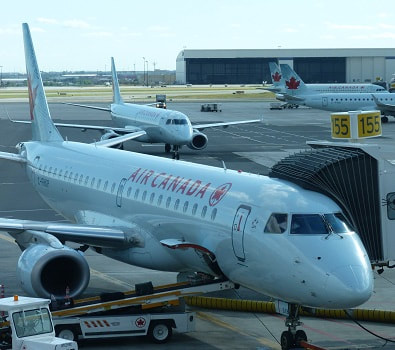Air Canada To Cut Capacity
June 18, 2008
Air Canada plans to drastically cut its capacity and slash up to 2,000 jobs starting this fall, and warned deeper cuts may follow if fuel prices remain where they are today. With the price of fuel more than doubling at the country's largest carrier last year -- leading to an additional $1-billion in costs -- Air Canada said it would be forced to ground some of its less-profitable routes starting in October and continuing throughout the winter. "Air Canada, like most global airlines, needs to adapt its business and reduce flying that has become unprofitable in the current fuel environment," said Montie Brewer, the airline's chief executive, in announcing the cuts yesterday. While Air Canada is still working on specifics, not surprisingly the airline's U. S. transborder routes will be hit the hardest, with the U. S. economy and higher airfares brought on by bigger fuel bills conspiring to send demand on those routes slumping. In the past two months alone, the rising cost of fuel has forced U. S. airlines to collectively slash 8,600 jobs and deeply cut capacity, mainly to smaller cities. For three straight months, Air Canada, the largest player in the U. S. transborder market, has been reducing its capacity to the United States by switching its larger aircraft on those routes for smaller Embraer-built regional jets. Air Canada said it plans to cut capacity on its domestic routes by 2% and on its international routes by 7%, and would slash its U. S. routes by 13%, leading to a systemwide capacity cut of 7%. This is the second time this year Air Canada has scaled back its capacity growth expectations for the year, which have gone from a 4% increase to flat or slightly negative. "Air Canada is not immune from the plague that is effecting all North American airlines," said Paul Dempsey, director of McGill University's Institute of Air and Space Law. "Fuel is driving many airlines, including Air Canada, to try to cut cost, cut capacity and to ground less fuel-efficient aircraft." The situation may get worse with most analysts predicting the fuel surcharges recently adopted by Canadian carriers, and the higher fares, will eventually have an impact on demand in the strong domestic market, especially after the busy summer season ends. WestJet Airlines Ltd., which enjoys an estimated 30% cost savings over its larger domestic rival, has no plans to lay off employees and will push ahead with its plans to add 16% capacity to its network this year, and possibly steal market share from Air Canada as it pulls planes out of the domestic market, according to Richard Bartrem, WestJet spokesman. While Air Canada says it is working with its 28,000 employees to "minimize the involuntary layoffs," union leaders estimate at least 650 ground crew and cargo workers, 500 flight crew and 400 customer sales and service agents will be affected by the job cuts. An Air Canada Pilots Association spokesman said the group was "uncertain" about the impact the cuts will have on its members, which are typically much more expensive to retrain after a layoff than other employees. The way Air Canada handles the cuts will likely affect its dealings with the unions in its next round of labour talks slated for next summer. The unions say despite the current hardship, they will be looking to make up for some of the $1.1-billion in wages and benefits they gave up when Air Canada was in bankruptcy protection. "There's always something -- SARS, 9/11, bankruptcy," said Nick Beveridge, vice-president of CUPE's Air Canada unit. "Fuel prices are just the current big problem." FlyForLess is not affiliated with any media companies nor does it represent or work for Air Canada. This article is published with the sole purpose of making information available for those who wish to stay informed on Air Canada's actualities. |
|

|
|
Discount Airline Tickets | Flights | Airports | Privacy Policy | About Us | Contact Us
FlyForLess.ca is an affiliate of Aviasales/JetRadar, a leading flight search engine that allows users
to compare airfares from over 700 airlines and travel agencies in order to find the cheapest flight tickets.
We offer discount airline tickets with a database of over 2 million international airfares, as well as car rentals, hotels, and vacation packages
with departures from cities across Canada. Book your cheap flights, discount car rentals, and special hotel rates with FlyForLess.ca
©2023 FlyForLess.ca. All rights reserved
FlyForLess.ca is an affiliate of Aviasales/JetRadar, a leading flight search engine that allows users
to compare airfares from over 700 airlines and travel agencies in order to find the cheapest flight tickets.
We offer discount airline tickets with a database of over 2 million international airfares, as well as car rentals, hotels, and vacation packages
with departures from cities across Canada. Book your cheap flights, discount car rentals, and special hotel rates with FlyForLess.ca
©2023 FlyForLess.ca. All rights reserved
